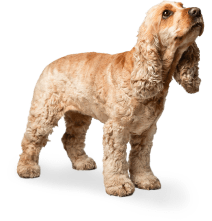

Acid Reflux in Dogs
You’ve probably heard a family member complain about acid reflux, and yes, dogs get it too. Reflux happens when fluid flows in the wrong direction, in this case back up the oesophagus (food pipe) from the stomach. The stomach is designed to handle acid, but the oesophagus isn’t. When acid makes contact, it causes inflammation, damage and pain, which humans often call heartburn. Let’s explore what causes it, the signs to look out for, and how it can be managed.
Can dogs get acid reflux?
Yes. Acid reflux in dogs is relatively common. It may be a short-term, temporary issue—for example, occurring during anaesthesia—or a long-term condition linked to an underlying problem. Because of this, symptoms can range from mild and occasional to severe and persistent. Some dogs need only small lifestyle adjustments, while others require ongoing medical treatment. When reflux is long-term or more severe, the medical term gastroesophageal reflux disease (GERD) is used.
Acid reflux in brachycephalic dogs
Brachycephalic dogs—short-nosed breeds like Bulldogs, Pugs and Frenchies—are especially prone to more serious GERD. Breeding for shorter muzzles means these dogs often have breathing difficulties that create big changes in pressure inside the chest and abdomen. These stronger "push and pull" forces don’t just affect their lungs; they also impact the oesophagus and stomach, making reflux more likely
Brachycephalic breeds are also more prone to stomach inflammation and problems with oesophageal function. Combine this with a tendency to overeat and gain weight, and it’s a recipe for reflux.

Symptoms of acid reflux in dogs
You’re unlikely to notice reflux happening, but you’ll notice signs linked to oesophageal inflammation.
• Reduced appetite or difficulty swallowing
• Lip licking, drooling or unusually bad breath
• Gagging, regurgitation (food or fluid falling effortlessly from the mouth)
• Coughing or changes in their bark
• Signs of pain such as whining or restlessness
• Weight loss over time
What causes acid reflux in dogs
Acid reflux happens when the muscular ring at the entrance to the stomach opens when it shouldn’t, allowing acid to flow upwards into the oesophagus. This can happen for several reasons:
1. Mechanical or anatomical issues
• Hiatal hernia: when part of the stomach slips through the diaphragm into the chest. It’s highly likely to cause reflux but is uncommon, except in predisposed breeds.
• Trauma: injuries, foreign bodies, caustic substances, or medical procedures can damage the stomach entrance or oesophagus.
2. Muscle weakness and functional problems
• Weak muscles: ageing, neuromuscular diseases like myasthenia gravis, or other motility disorders can reduce the strength of the muscle at the entrance to the stomach.
• Poor timing: the stomach entrance is meant to relax briefly, for example, when burping. In some dogs, this happens too often or at the wrong time, especially when the stomach is full.
3. Gastrointestinal or inflammatory factors
• Gastrointestinal inflammation: not only oesophagitis and gastritis, but also conditions like pancreatitis or hepatitis can slow stomach emptying and increase pressure.
• Excessive stomach acidity: more acid means more damage when reflux occurs.
4. Breed-related risks
Alongside brachycephalics, breeds such as German Shepherds, Golden Retrievers, Labradors and Boxers may have motility disorders, megaoesophagus, or hiatal hernias that increase their risk. But any dog — especially if overweight — can develop reflux.
The reflux–damage cycle
Once reflux begins, the acid damages the oesophagus and can, over time, weaken the muscle at the entrance to the stomach further. This sets up a vicious cycle: reflux causes damage, the damage worsens reflux, and the condition can become chronic unless managed.
Treating GERD in dogs
The main goal is to protect the oesophagus and allow healing. Depending on the underlying cause and severity, treatment may involve:
- Protecting the lining: Some drugs can act like a bandage protecting damaged areas of the oesophagus.
- Reducing acidity: Acid-suppressing drugs to reduce ongoing damage.
- Improving motility: Prokinetic drugs can tone up the sphincter a little but also speed up stomach emptying.
- Managing complications: If reflux leads to aspiration pneumonia, prompt antibiotic treatment is vital.
- Pain relief and anti-nausea meds: To improve comfort and prevent further irritation from vomiting.
- Surgery: In rare, severe cases (such as hiatal hernia or unmanageable reflux), corrective surgery may be considered.
- Diagnosis specific treatments: Other underlying conditions also need addressing.
-
Lifestyle and management changes: These are a vital part of long-term control; we’ll cover them next.
How to prevent acid reflux in dogs
Because you can’t simply give a pill that restores normal sphincter function, reflux can’t be prevented outright. But you can tip the scales in your dog’s favour and reduce the risk of flare-ups or complications like aspiration pneumonia.
- Be extra cautious with brachycephalic dogs: Monitor these breeds closely for subtle signs of reflux.
- Act early: Prompt veterinary care helps prevent the reflux–damage cycle from taking hold.
- Meal management: Feed smaller, more frequent meals instead of large ones.
-
Feeding position: Elevated bowls can reduce backflow.
- Diet: Low-fat, easily digestible foods promote faster stomach emptying. Avoid potential irritants.
- Weight control: Keeping dogs lean reduces abdominal pressure.
- Rest after meals: Avoid vigorous play or exercise immediately after eating.
With the right combination of medical care, diet and lifestyle changes, most dogs with reflux can remain comfortable and avoid long-term complications.



